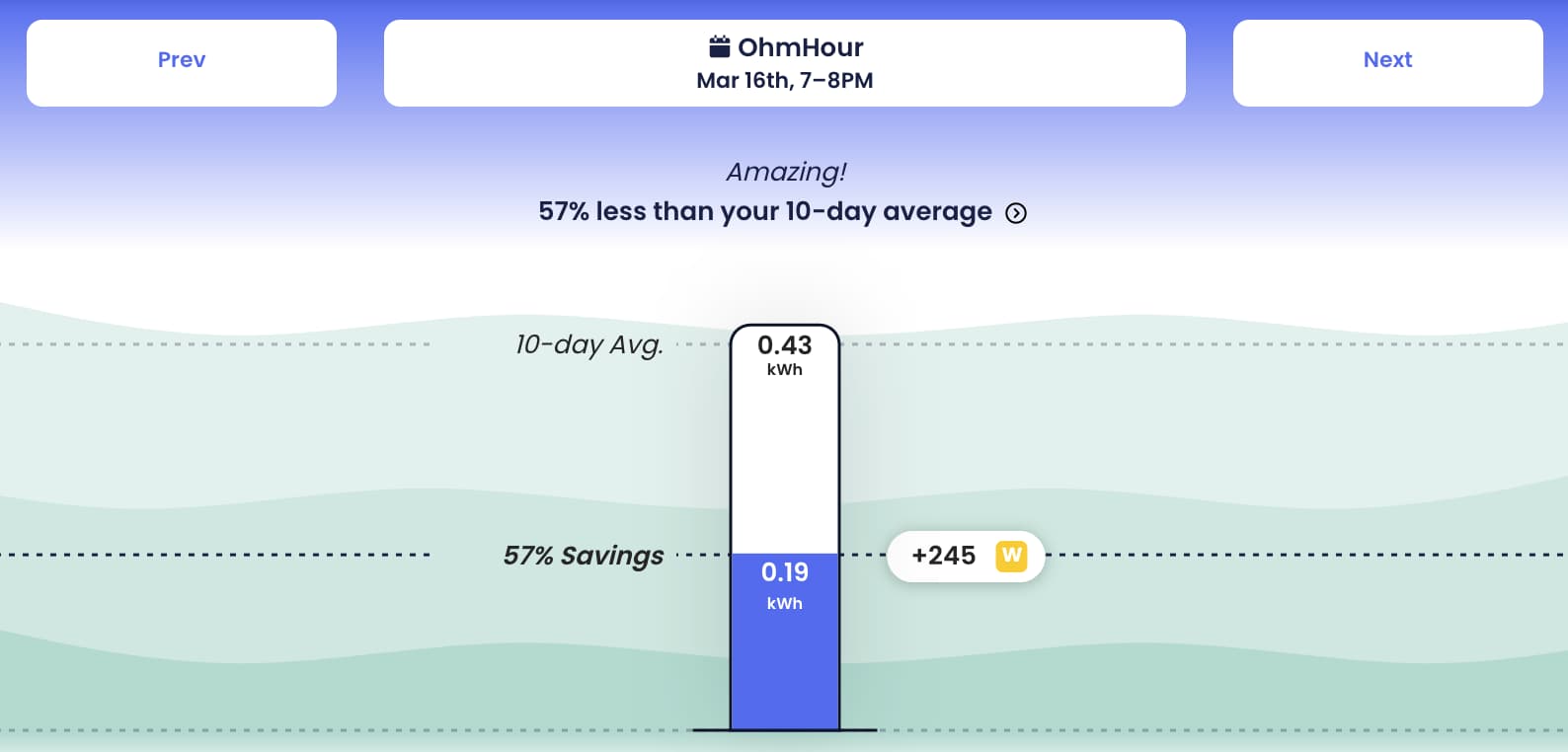Why I'm turning my home into a virtual power plant
On September 9th 2020, I woke up to find that the sky outside of my window looked like this:

Smoke from nearby wildfires was trapped over the Bay Area, making the region look like the surface of Mars. It's hard to describe the feeling of walking around my neighborhood with it looking like the set of Blade Runner, but the one thing I can say is that it made the immediacy of climate change paramount.
That morning a switch flipped in my brain. I couldn't keep doing my job and ignoring what was literally happening outside of my window. I decided to leave Google to look for a role doing something—anything!—connected to climate.
Today I want to talk about a clever idea I learned about during my job search. I think it is potentially a transformational new industry and one that many, if not all of us, will participate in: turning every home (and apartment) into a virtual power plant ⚡️
On the surface that just sounds cool, right? But what does it actually mean? To understand how it works we first have to understand how the grid operates and what happens when there's not enough power to go around.
How the grid works
The power grid is a balancing act—there’s the amount that consumers are trying to use—the demand—and there’s the amount being generated by power plants—the supply.
Sometimes, like on the hottest day of the year when everyone is running their air conditioners, demand outpaces supply. During these times, the grid operator has to go to the energy market to buy more power to respond to the demand.
Depending on the situation, this might mean calling up a peaker plant. These are fast-acting—and very dirty—fossil fuel plants that can ramp up quickly.
There are a number of problems with peaker plants:
They’re expensive to operate
A new report has found that New Yorkers over the last decade have paid more than $4.5 billion in electricity bills to the private owners of the city’s peaker plants, just to keep those plants online in case they’re needed — even though they only operate between 90 and 500 hours a year. source
They’re dirty
Many of these facilities are 50 or more years old, lack modern pollution controls, and run on dirty fuels like kerosene or oil source
They damage the health of our communities
They're predominantly located near population centers where energy demands are greatest and typically located in communities of color and under-resourced areas. There are more than 1,000 peakers in operation across the country today source
Ironically, as we’ve moved from using fossil fuels to renewables like wind and solar, some electric utilities have proposed building more peaker plants to make up for the intermittent nature of renewables.
An alternative to peaker plants is that we could all agree to use less energy when the grid is under strain. But this presents a coordination problem: consumers don’t know when the grid is under strain, so they don’t know when to use less energy, and therefore grid operators cannot rely on these energy savings.
So how do we solve this coordination problem?
Demand response
As I mentioned earlier, the power grid is a balancing act. One way to balance the grid when demand is high is to generate more power. The other way is to lower demand, a.k.a. "demand response".
In other words, if you and I agree to unplug our refrigerators for an hour when the grid is under strain, then we help rebalance the grid by lowering the demand.
Where this gets interesting is when you think about aggregating that collective action. Instead of unplugging one refrigerator for an hour, we unplug one million. Now we’re talking about megawatts of power that can be “generated”, on-demand, to rebalance the grid.
Technically we're not generating new power, but the net effect is the same. If the grid needs one megawatt of power, and we turn off one megawatt’s worth of refrigerators, then everything evens out.
Rather than thinking of these as megawatts generated, you can instead think of them as “negawatts” saved (yes, that is an actual term used in the industry).
If we all knew when to turn off our refrigerators (or thermostats/lights/space heaters/air purifiers/EV chargers/etc.), and we understood energy markets well enough to sell energy into them, then we could act as a kind of virtual power plant. When a grid operator needs power, instead of going to a dirty peaker plant, they could instead call up our virtual power plant and pay us for our negawatts!
It might seem odd to think about selling energy that we didn’t use, but according to the Federal Energy Regulatory Commission (FERC), we can do just that. Negawatts are priced and sold just like megawatts.
To do this sort of collective action, we need aggregators: someone to tell us when to reduce our energy consumption, who can handle selling that energy on our behalf. This is where startups like Voltus and OhmConnect (to name a few) enter the picture.
These companies present themselves as virtual power plants to grid operators and sell negawatts at a cost per kilowatt hour. They generate these negawatts by sending notifications to their users who then reduce their energy consumption during specific times. When Voltus or OhmConnect gets paid by the grid operator, they pass a percentage of that payment on to their users.
Voltus mostly targets industrial customers (steel mills, factories, etc.) but they told me that they plan to do more consumer demand response soon. OhmConnect, on the other hand, is entirely consumer facing and currently operates in California, Texas, and New York. I’ve been using OhmConnect since February 2022—about two months—and have so far earned around $100 through a combination of energy savings and referrals.
While the money is a nice bonus, what most excites me about OhmConnect is feeling like I'm participating in a social experiment to improve grid intelligence and help the climate. I had wanted to add smart lights and plugs to my home for convenience, but this creates an additional incentive when I can think of my home as (part of) a virtual power plant.
Let me walk you through an example so you can see how it works.
One OhmHour
When the grid is really busy, OhmConnect sends me a notification with a specific time—an OhmHour—during which I should ramp down my power consumption. OhmHours typically occur once per week, and they notify me a day or so in advance, and then an hour before the event begins.
During the OhmHour I'm rewarded in points—called watts—based on how much I reduce my consumption. Watts can be exchanged for cash (via PayPal), spent on discounted smart devices, or used for contests: free groceries for a year, an e-bike, that sort of thing. OhmConnect also pays me cash for referring new users. It varies by state, but I earn $40 if I refer a fellow Californian, and the referee receives $10.
There’s no requirement to connect devices to OhmConnect—you can walk around your house and manually turn things off during an OhmHour—but I found it easier to let them do it for me, plus I receive bonus watts for every connected device. So I connected my Nest thermostat and a smart plug powering my refrigerator to their system.
During the event I'm graded on how much energy I save compared to my previous 10-day average. For example, on March 16th from 7-8pm, I reduced my consumption down to 0.19kWh from an average of 0.43kWh.

I didn't have to radically alter my life to achieve these savings. During this specific event, I was watching TV on the couch with my wife. But prior to the OhmHour starting I turned off the unused lights in my house and put my dishwasher on a timer so it would start later in the evening. My refrigerator automatically turned off and my thermostat switched to eco mode.
Brief aside: Did you know that most dishwashers have a timed start feature? This is really helpful if you're on a peak time-of-use electricity plan!
In total I earned 605 watts during that OhmHour: 245 watts in energy savings + 360 bonus watts for having two smart devices connected to my account (320 for my thermostat and 40 for my smart plug). Because you can use watts to buy more smart devices, which then grant additional watt bonuses, you can see how this turns into a positive feedback loop.
Is this a scam?
OhmConnect is clearly trying to gamify this process—apparently the CTO used to work at Zynga—so there are streaks and levels that increase the discounts you receive when you exchange your watts for smart devices. You can also spend watts to increase your referral bonus, something I’ve done in the past before referring a few of my friends.
Does it feel a tad like a multi-level marketing scheme? Sure. But if you understand the demand response / virtual power plant model, you can see that they’re actually making money by selling negawatts to grid operators and paying you a percentage of that when you cash out your watts or use them to buy subsidized smart devices.
So it really is more of a social game where reducing CO2 is the goal and there are financial incentives. It's a novel approach to climate change because it takes the addictive engagement and recruitment model of Farmville but uses that power for good. Who would have ever thought that Farmville could help save the planet?!
Privacy concerns
I think it’s fair to mention that participating in OhmConnect does require sharing some data. For OhmConnect to work, it first needs to know how much energy you're using, which means giving them access to your energy data via your utility's website. In addition, you're rewarded for connecting smart devices to your account, which lets OhmConnect turn those devices off during an OhmHour.
I can totally understand being concerned about a third-party having the ability to turn off your refrigerator, but you can always opt-out of the OhmHour or walk over and turn your refrigerator back on (or through the smart plug app on your phone). Another option is to only use the smart plugs for less critical devices.
Since you're only rewarded based on your energy savings, if you choose to completely ignore the OhmHour there's no real penalty, you just won't earn any watts.
The way I see it, giving OhmConnect the ability to ramp down my power consumption acts as a kind of backpressure model for the grid, so even if I’m not at home, my devices can quickly switch off and hopefully do a bit of good. Also, I’ve learned that an unopened refrigerator has enough thermal inertia to safely be off for around four hours 😄
Give it a shot!
If you’re interested in trying OhmConnect you can use my referral and we’ll both get some money 🙌 When you sign up they will offer to send you a smart plug for $1. Technically you have to pay the full $11 and then they refund you $10 if you connect the device to your account (I can verify that they did refund me).
If you want to learn more about their business I recommend checking out the My Climate Journey interview with their CEO, Cisco DeVries.
I should also mention that both OhmConnect and Voltus are hiring!
I think this is such a cool space and am excited to see where these companies go in the future. If you do give OhmConnect a shot, give me a shout on Twitter and let me know how it goes for you!